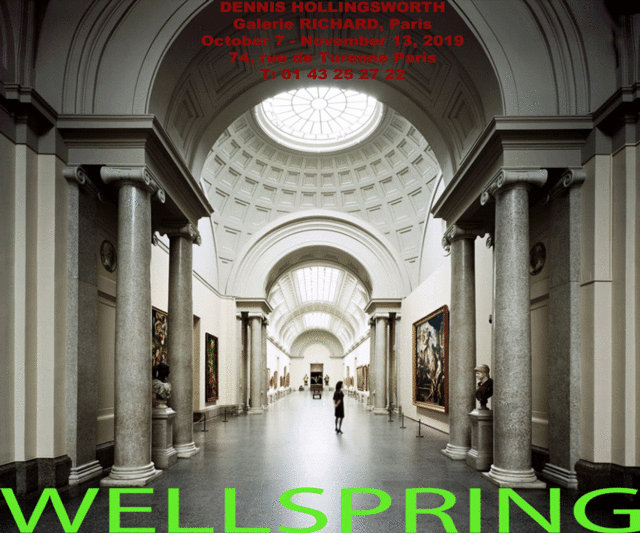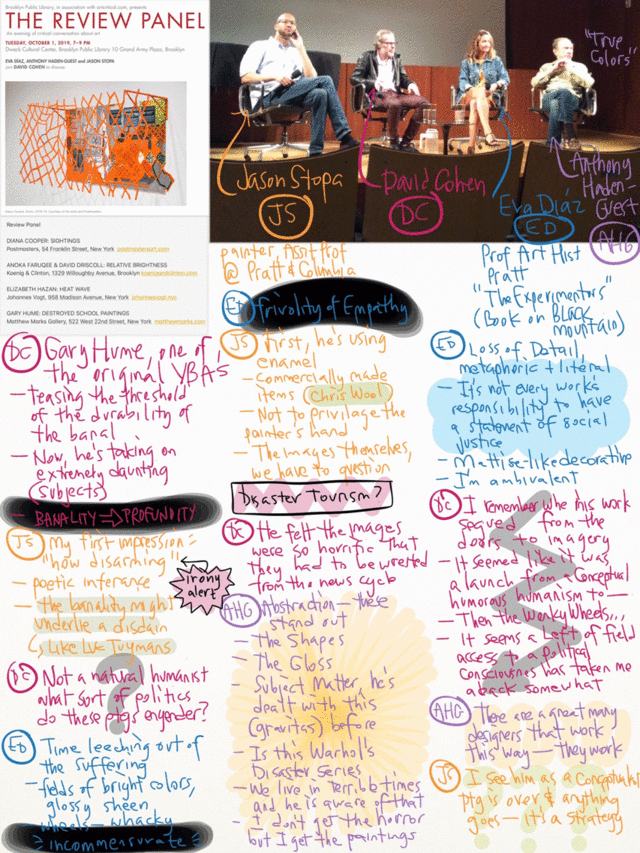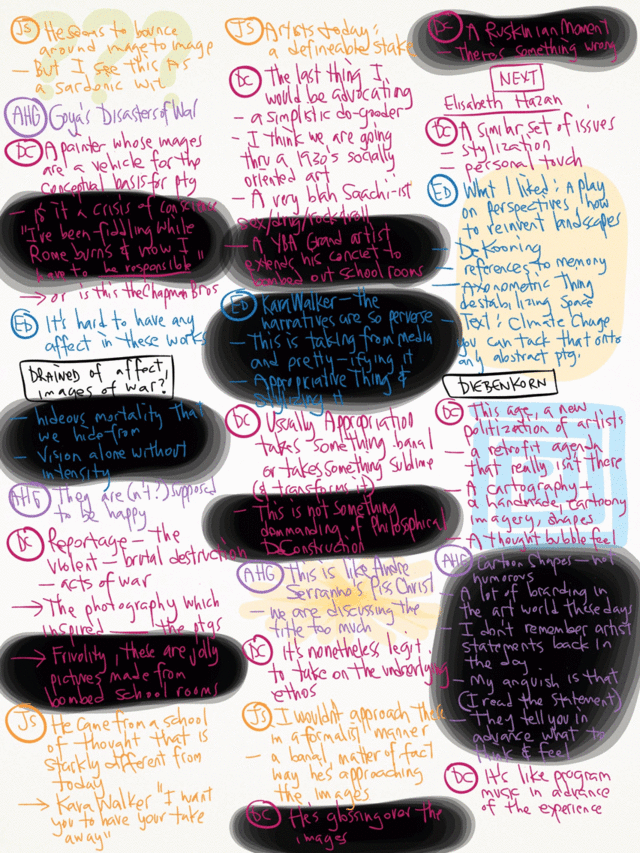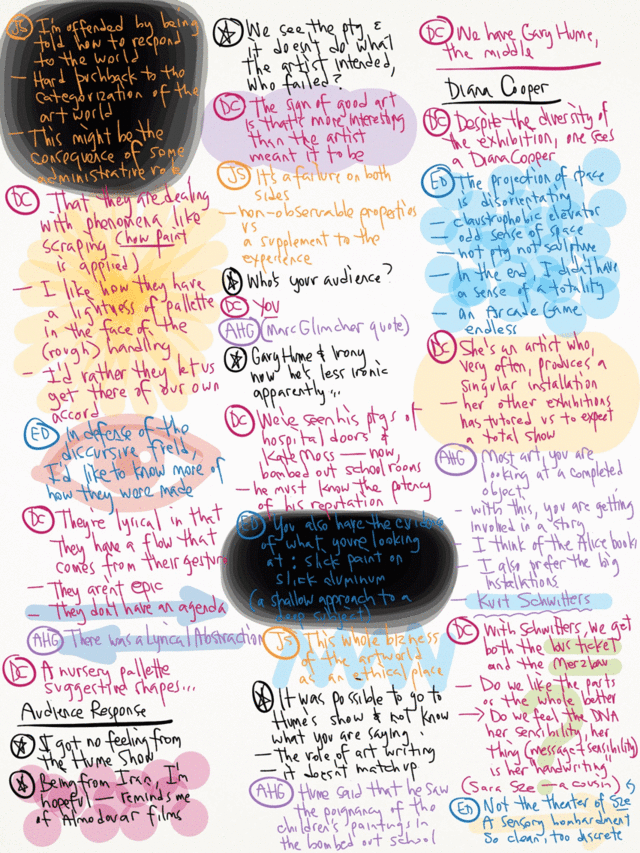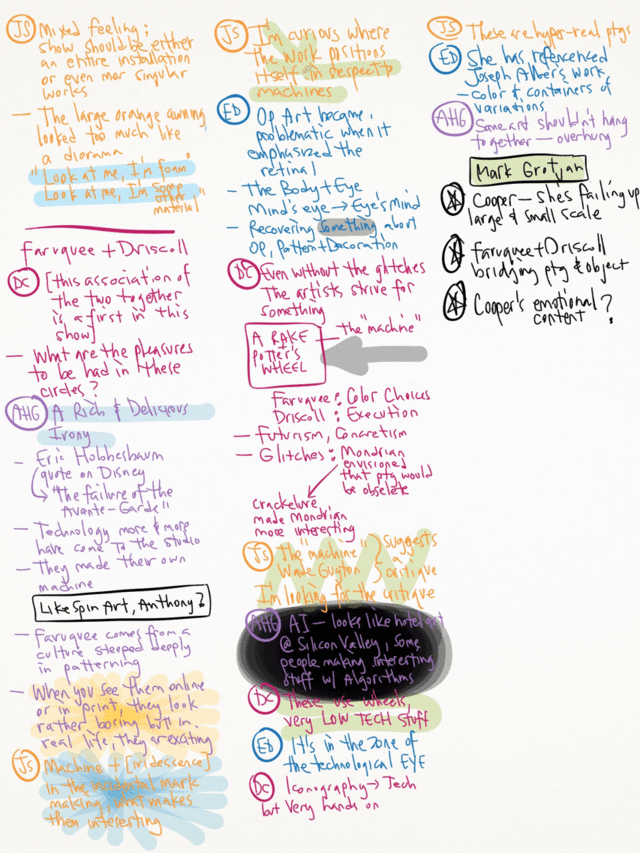October 14, 2019
Temporal and Atemporal...
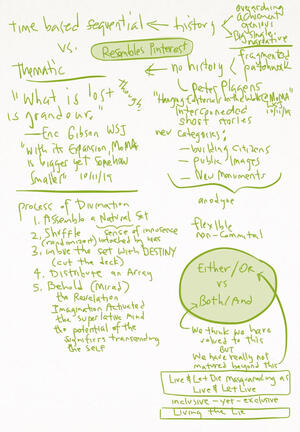
Much of my anticipation of visiting the newly renovated MoMA was shaped by the debate concerning the curatorial direction of the museum going forward. Peter Plagens wrote in the Wall Street Journal in his article Hanging Editorials on the Walls at MoMA:
...witness the banishment of such well-known indicators as "Abstract Expressionism" from its list of anodyne gallery titles that includes "Building Citizens," "Public Images" and "New Monuments." The museum also wants to remain flexible, almost noncommittal. (The hyper-accessible label "Pop Art" is veritably infantilized into "From Soup Cans to Flying Saucers.")
The words ...anodyne... noncommittal... hang in my mind. Also in the same paper, Eric Gibson wrote under his headline With its Expansion MoMA is Bigger Yet Somehow Smaller: "What's been lost, though, is grandeur." So, I was prompted to expect a travesty of historicism and a devolution into a Pinterest world of triviality. Instead, I was pleasantly surprised to find that historicism was maintained amidst a plethora of curatorial themes, such as (this list is randomly selected from 78 thematic galleries.):
-Inner and Outer Space
-Surface Tension
-Stamp, Savage and Crush
-City as Stage
-Idea Art
-Machines, Mannequins, and Monsters
-Responding to War
-Picturing America
-Paris, 1920's
-From Soup Cans to Flying Saucers
Jerry Saltz's recent piece in Vulture What the Hell was Modernism? sings of modernity, "the King is Dead, long live the King!" Simultaneously, he celebrates and condemns modernism, saying on one hand that it sought to end history and on the other that it perpetuates a history stained with Politically Correct sin.
Before I go on, I should render as a relevant aside, a quick run down of my own perspective concerning this sweeping topic. I've touched on this many times elsewhere in this weblog, so I'll bullet point them:
-To be modern is to reconcile the life one is living with the things one is making.
-Modernism and Postmodernism were born simultaneously at the collapse of Classicism.
-Classical canon crumbled when industry and material innovation went into overdrive.
-Modernists sought to create a new canon.
-Postmodernists didn't believe canons were possible or desirable.
-Modernism crystalized at the high point of NYC AbEx, it was the effort to touch G-d (transcendence) via material means. No one survives contact with G-d.
-Postmodernism's turn at its flowering during the zenith of Modernism was to flip the script: to point to (but not touch) everyday life (not G-d) via conceptual (not material) means.
-Pop pointed to everyday life, but was still ensnarled in the painterly facture of their Modernist antecedents.
-Minimalism turned down the dial of materialism in artwork until the conceptual remained in view.
-Sol LeWitt was the fruit of the Postmodern tree, he clairvoyantly anticipated the information age, focusing on art as a series of instructions.
-Postmodernism continued past its prime, elaborating alternative means of pointing to everyday life: CriticalTheory, Deconstruction, the personal = political...
-As a river begins as condensate in misty mountaintops, it follows as a crisp and cold stream, then widens into a slowing dirty course, eventually fanning into a stinking silted delta... so too Postmodernism.
-We are living in the delta phase. We can only hope we are the ones evaporating into clouds that will later form dew into new mountaintops.
In Saltz's long article, he lists the exploded assumptions of Modernity indicated by Ann Tempkin. (I've appended my initial reactions -in bold type- to each in train.)
***
So -- what was assumed? Let's look at five big things."Making it new" led to "art is dead"?First, there was Ezra Pound's cri de coeur "Make it new." In modernism, only newness was given value. Everything old was considered passé, inadequate to address the times, which meant modernism claimed not just a monopoly on newness but also on importance. ... It's the same way each generation thinks it has invented sex; newness is as old as time. The modernists were just a lot cockier about saying so.
If newness is as old as time (clever, that), then it's also enduring.
If the new = the now, then the present also implies the past and future simultaneously. History automatically flows.
Second, modernism called itself reality. Which meant, perversely, it didn't have to bother to address or depict actual reality -- instead, it offered itself as the only thing that mattered. ... Viewers were expected to look through subject matter. You weren't seeing a landscape; you saw how this artist reinvented the landscape.Calling itself the ultimate reality (Modernism) meant that reality (the world outside of an art work) was simultaneously denied (Postmodernism). Thus in train (on the tracks towards Paradise), was coupled truth and G-d, and the shared world. Reality, rendered luridly enough, leads to unreality. A disabling surfeit, like snow blindness.
Third, modernism was built on the principle that formal experimentation is the only thing that matters. ... Art had to be seen all at once, not sequentially or with any formal hierarchy. (That meant it couldn't have narrative.) ... Modernism was philosophically colonialist this way and loved declaring everything as its own, all while asserting it was inventing even those things it was stealing.Formal experimentation = Colonialism? Meaning, it looked for difference outside of Western Civ's context, implying plunder from civilizational contexts other than one's own?
Fourth, there was the principle that modern art would "kill history" -- a hysteria of finality. ... In wanting to destroy the whole history of Western art, modernists were like an aesthetic Taliban. Except for the art they approved of, everything else was deemed bourgeois, Establishment, bad taste, or kitsch... History didn't exist unless you were making it. (It's always the end-times again in modernism.)The urge to kill history is an eschatological one. History implies a path in time and therefore a destination. "Are we there yet?" Is the child's insistent and obnoxious query. It is also the anxious torque of forward momentum where the vector always points towards the future. Moreover, this urge is also a death drive, (Freud's) Thanatos, and the thrill of seeking to overcome oneself in history.
Fifth, there was modernism's grand teleology -- the whack-rationalist idea that history was to proceed in a predefined order. If you didn't fit, know, or care, or were a visionary, an artist of color, or female, tough luck. Only the things in its timeline were deemed progress. Progress was to be the goal of all art.Teleology isn't order, it is the assumption of a final purpose, an end goal. There's nothing whacky about seeking order in the phenomenal world. Morning leads to night. Apples fall from trees. These things have nothing to do with skin color or sexuality and only racists would make this argument either on the Right or the Left. The idea that a timeline would be singular and ultimately defining is the Sophist's or hustler's trick. The sequence and summation of time will always be variable, provisional and eligible for contention.
***
Saltz takes pains to say what is obvious (yes, at least to me) yet lost on many (yes, this probably includes you, dear reader), that Modernism and Postmodernism are complimentary and more than twins in the larger project of the 20th Century. Quoting Saltz again: "What began with Pop and Warhol looked like a break from modernism, but it also extended modernism's fetishizing of novelty and a canon of iconoclasts." But what he seems to miss is that it was at the height of Postmodernism that Francis Fukuyama wrote The End of History and the Last Man precisely at the moment of the fall of the Berlin Wall and the end of the Cold War. This was the idea that Liberal Democracy had triumphed and no further development of political order was necessary in the world. We have reached the end of history according to this idea, and no other iteration of improvement in civic order was needed or possible. What was left to be done was to spread this order to the parts of the world who have yet to enjoy it. Implicit in this tantalizing thought was the Modernism and Postmodernism that had shaped it in the first place.
The current passion for overcoming the historical narrative in museums is itself another End of History narrative. Laura Hoptman wrote in her introduction to the landmark MoMA show "Forever Now", "What characterizes our cultural moment at the beginning of this new millennium is the inability -or perhaps the refusal- of a great many of our cultural artifacts to define the times in which we live." It is to her credit that it was in her first line that she admitted to the possibility of a willful blindness. I remember conversations in my own art community in the 90's (Los Angeles at the time) where it was considered bad form to mention Postmodernism even in passing, it was considered too "Essentialist" to do so. Time has passed and the need to give a name to our pain remained. Certainly, this is the source of anxiety that the trigger happy critics of the MoMA expansion are preoccupied with.
Let's look again at Saltz and Tempkin's provocative five.
-His fifth charge: the grand teleology. We had arrived at paradise, the only thing left to do was clean up.
-The fourth charge: the death of history. Nothing can be permitted to succeed Postmodernism, else the wrongs it had righted would re-manifest themselves again.
-The third: the folly of experimentation replacing narrative. Postmodernism requires that corrective narratives linger in the spotlight.
-Second, the obnoxious Modernist reality and perverse unreality of Postmodernism. Outside of time, there are only dreams.
-And the final crime of our Modernist father, "making it new". Postmodernism rendered the new into mere novelty and an oppressive one at that. It was because history was over that an artist should not be so foolish as to attempt newness. All that was possible were pale imitations of greatness past.
The 20th century ended in a paroxysm of negations. Titans of Modernism wanted to paint the last painting. Titans of Postmodernism wanted to stomp the compass of essentialism and get lost in the Forest of Signs. G-d was dead, truth was dead, the author was dead, painting was dead. I hope that by now you see and agree, that the central problem is that when history is dead, the only acts of creativity are the ones that are carefully circumscribed, lest you risk spoiling paradise. The book of art is written. Artists can only legitimately create end notes and bibliography. When history is dead, no subsequent chapters can be written. Every subsequent generation of artists are constrained.
When history is dead, art is dead.
To reiterate my take on the newly renovated MoMA, I was pleasantly surprised to fine a good blend of historical succession and what could be referred to as Michel Foucault's Archaeology, an analytical tool for uncovering alternative and disturbed histories of systems of knowledge, an unstructuring of legacy knowledge and categories. The spotlight and the periphery, together. Human sight, after all is a blend of focus and wide angles, a phenomenon not merely retinal, instead richly conceptual and wholly referential to a shared noumenon unobtainable outside of our senses.
It may all boil down to this earnest hope: that IF the 20th Century was about Either-Or, THEN the 21st is about Both-And.
Postscript 1:
The challenge of curation.
I thought of Pinterest in critique of the problem of flaccid curation. Certainly, the use of that platform is not in itself problematic, it's a great tool in and of itself. But by and large, the categorization one usually finds from its users tends to be slack.
Divination came to mind as a way to address the challenge of selecting the few from the many. Certainly, inspiration is the motor. So, I worked out as best as I could, the train of actions necessary in this process:
1. Assemble a Natural Set. It has to have a sense of innocence about it, unbiased.
2. Shuffle the set, randomize its order.
3. Imbue the set with Destiny. In poker or Tarot, the subject cuts the deck.
4. Distribute an array. The order must be predetermined, the arrangement delivers the signal.
5. Behold the revelation.
The diviner becomes the medium, a gaze powered by an imagination focused on destiny of the subject.The self on both sides is overcome, the signal from the noumenon manifests itself.
Of course, the shortcut to all this process is an intimacy with real imagination. This, the realm of all real artists.
***
Postscript 2:
From the press kit for Artist's Choice: Amy Sillman--The Shape of Shape:
...In this exhibition, Sillman presents a highly personal exploration of shape--the ever-shifting boundaries that define what and how we see--in modern art. Works spanning vastly different time periods, places, and mediums engage the eccentric forms and unpredictable contours of bodies, fragments, gestures, and shadows. Sillman examines the creation of shape as an act of subjective choice--in contrast to art made by following systems, rules, or grids, conventions that have often dominated artistic practice throughout the 20th century. The Shape of Shape is organized by Amy Sillman with Michelle Kuo, The Marlene Hess Curator, and Jenny Harris, Curatorial Assistant, Department of Painting and Sculpture. Reflecting on her curatorial process, Sillman said, "Even though shape is everywhere, we don't talk about it much; it's not a hot topic in art, like color or systems. So I decided to look for works in MoMA's collection in which shape does prevail over other considerations. I found a wealth of artworks, far too many to include here, by artists who dig into life's surfaces, who start with physical perception rather than abstract logic. Often eccentric, poetic, or intimate, these works are like bodies that speak, operating at the hub of language and matter, signs and sensations..."
I found the curation focusing on shape qua shape to be rather dull. I'll have to double check this impression with another visit, but this was my first take. Searching the collection for this simplistic criteria... how could Sillman and MoMA allow this project go to completion without some challenge of imaginative ambition? Shape, yes, I myself have based my own entire oeuvre on re-establishing the formal dimension of paint in painting... but tell me more, MoMA. While I found this gallery to be a welcome formal contrast to the rest of MoMA's presentations (art work presented on and slipping off the walls), the popular celebration of its unconventionality is a bit overhyped. A quick search of historical precedent: Malevich's The Last Futurist Exhibition of Painting 0.10 (Zero Ten), Duchamp's First Papers of Surrealism, 1942, New York City... one could assemble quite a list in a short time. I remember a former grad school classmate who curated a controversial show in a major museum in Los Angeles, where she selected works from the collection and exhibited them in various states of un-crating, many of which remained in their crates, travel frames and wrappings. I thought it was a rather good exhibition, but the art community were up in arms that their works were not presented properly. Too bad that their selfishness got the better of them, that they could not understand and celebrate such an unconventional presentation, that the point of the presentation was to think of the life of an art work as that surrounded by a corona of conservation, shipping, storage and handling. So, yeah. Sillman's curation is at least not immediately inspiring and formally conventional.
Still, I should place any final opinion in abeyance until I take a second and slower look at it.
October 11, 2019
Wellspring: Richard Paris Installation
Here are the installation photos of my solo show at Galerie Richard, Paris. October 5 to November 13, 2019.
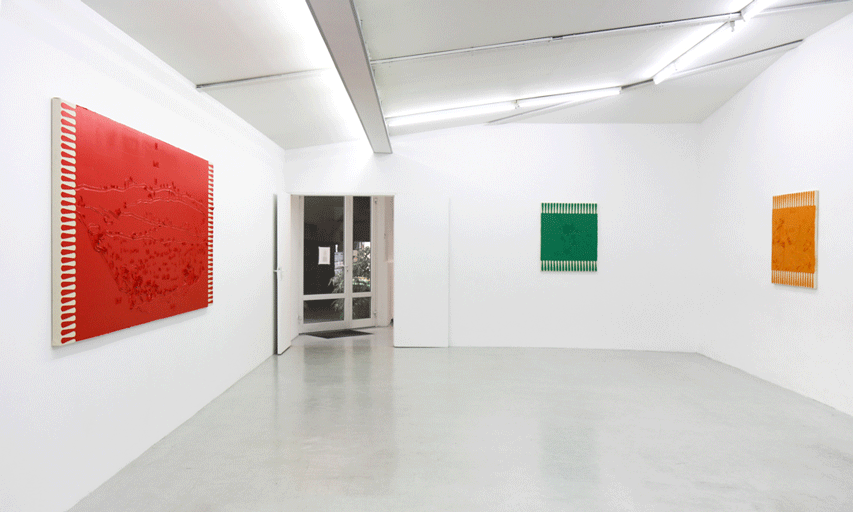
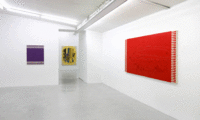
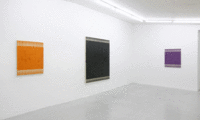
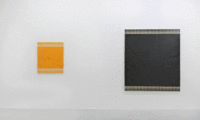
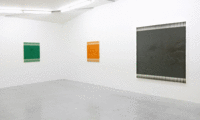
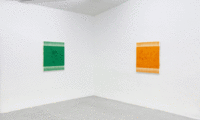
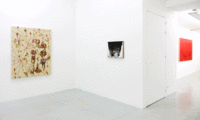
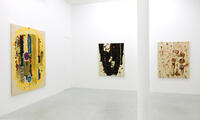
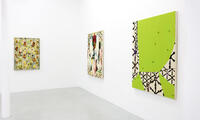
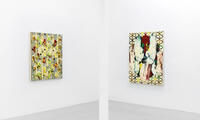
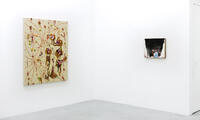
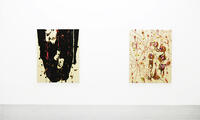
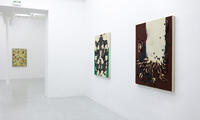
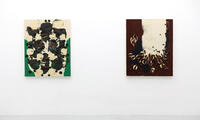
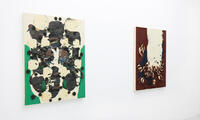
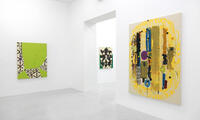
October 6, 2019
Juan Bufill: MMG: ABSTRACTIONS
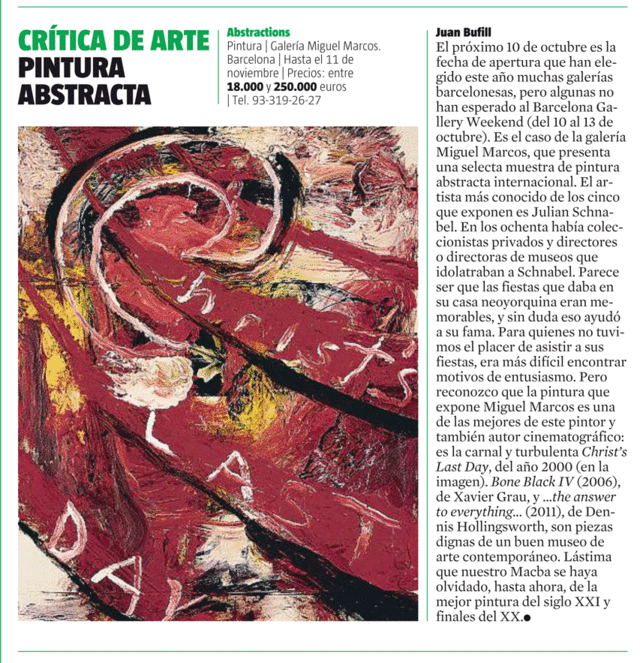
Barcelona critic Juan Bufill weighs in on Miguel Marcos' group show "ABSTRACTIONS".
Via Google Translate (fine tuned):
Juan Bufill Next October 10 is the opening date chosen
this year by many galleries in Barcelona, but some have not waited for Barcelona Gallery Weekend (from 10 to 13 of October). This is the case for Gallerie Miguel Marcos, who presents a select sample of international abstract painting. The artist best known of the five is Julian Schnabel. In the eighties there were private collectors, directors and museum directors that had idolized Schnabel. It seems to be that the parties given in his New York home were memorable, and that had certainly helped his fame. For those who did not have the pleasure of attending these parties, it was harder to find reasons for enthusiasm. But I recognize that the painting shown in Miguel Marcos' group show is one of the best of this painter and also film author: the carnal and turbulent "Christ's Last Day", painted in the year 2000 (illustrated). "Bone Black IV" (2006), by Xavier Grau, and "... the answer to everything ..." (2011), by Dennis Hollingsworth, these are pieces worthy of a good museum of contemporary art. Pity that our Macba (Museum of Contemporary Art, Barcelona) has forgotten, so far, of the best painting of the 21st century and late twentieth.
October 4, 2019
WELLSPRING
Jean-Luc and Takako Richard present the first solo exhibition of American painter Dennis Hollingsworth at Richard Paris titled "Wellspring", from October 5 to November 13, 2019. The exhibition is composed in two sections, a retrospective section and his newest monochrome paintings. "Wellspring" refers to his recent paintings which headline the exhibition. They commemorate the anniversary of the seminal moment in his early teenage years when he had realized that painting was his destiny as he stood mesmerized in front of Goya's "Saturn Devouring His Children" in the Prado Museum, Madrid.
"It was 1969, I was 13 years old. This was a specific moment of my experience in the Prado, after the sequence of the galleries of Bosch, Dürer, Velasquez, Ribera... that I came upon Goya: his cartoons for the tapestries, his court paintings and then his Black Paintings. I remember standing in front of "Saturn, Devouring His Children" and Goya's world of paint telescoped into my eyes and mind. Everything and everyone around me disappeared and the only things that existed for that long, super-saturated moment was this painting and me. I don't know exactly how long that moment lasted. It could have been forever, or it could have been only a minute. It could have been both. As the ordinary world returned to my senses, a resolution grew within me to become an artist, to become a painter, to return and remain in that realm so saturated with paint and churning with arts' urgent impulse."His journey fifty years hence is shown in a selection of paintings from different periods of time that tell the backstory of his oeuvre as an all-embracing introduction of his art to the Parisian audience. He achieved international recognition in the 90's by adding sculptural shapes of oil painting on raw canvases, making a statement about the revival of Painting in a prolonged period in which the mainstream intellectuals pretended that Painting was dead. For over twenty years, he has been searching for the extents of embodied paint. Within the limits of the surface tension of impasto, his recombinant lexicon of form involving prickly balls, stamps, stomps, flings, prints, and flowering peels of paint is screened and sheared through images of nature, text and the broken technological screen. Philadelphia architect Louis Kahn famously asked a brick what it wanted to be. Rhetorically, he was giving the nature of materials a voice in expression. Hollingsworth has asked impasto paint a similar question. The answer lies between the limited and limitless possibilities of the medium.
The expression of figurative references in monochromes is symptomatic of Dennis Hollingsworth's art. The Alpha and Omega of the monochrome, starting with "White on White" and ending with Yves Klein's "Blue Monochrome" have long been associated with the acme of Abstract Painting. The figuration within the abstract field of a monochrome is Hollingsworth's reference to Goya's paintings and an explicit turn from the absolutism implied in purist monochrome painting. The artist also purposely left the color of the canvas visible with a figuring edge mask, further problematizing the implicit end game of the 20th century monochrome. Dennis Hollingsworth escapes narrowly definitive classifications in these examples and others as it is his natural creative process to constantly innovate and surprise himself.
The diversity of his painting practice is mirrored in the diversity of his experience. Born in Madrid, Spain, his childhood was spent in eleven locations around the world, including Philippines, Panama, and Las Vegas. Once a sailor in the South Pacific and Indian Oceans, always an architect by way of his first degree, he is a graduate of the Claremont Graduate University in Southern California. His works are in the permanent collections of the MOCA Los Angeles, CA, The Nerman Museum of Contemporary Art, Overland Park, KS, The Akron Museum, Akron OH, The Akzo Nobel Collection, Amsterdam, Netherlands, The Colección Riera Roura, Barcelona, Spain.
Dennis Hollingsworth lives and works in NYC and in Tossa de Mar, Spain's Catalan Costa Brava.
October 3, 2019
ABSTRACTIONS: Galeria Miguel Marcos
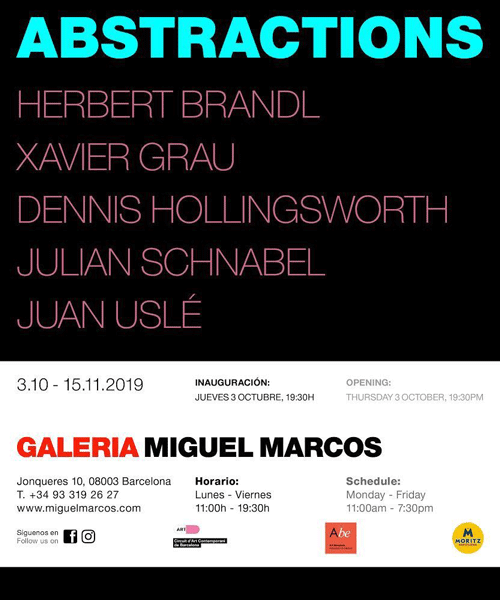
It's an honor to announce my participation in the group show "ABSTRACTIONS" opening tomorrow at Galerie Miguel Marcos, Barcelona, Spain.
October 2, 2019
Review Panel
The Fall 2019 Review Panel convened in the Brooklyn Library Dweck Cultural Center last night. Editor and creator of the online magazine artcritical David Cohen moderated a panel including Eva Díaz, Anthony Haden-Guest and Jason Stopa, all who offered commentary on these shows:
DIANA COOPER: "SIGHTINGS" at Postmasters.
ANOKA FARUQEE & DAVID DRISCOLL: "RELATIVE BRIGHTNESS" at Koenig & Clinton.
ELIZABETH HAZAN: "HEAT WAVE" at Johannes Vogt.
GARY HUME: "DESTROYED SCHOOL PAINTINGS" at Matthew Marks Gallery.
I took notes...

